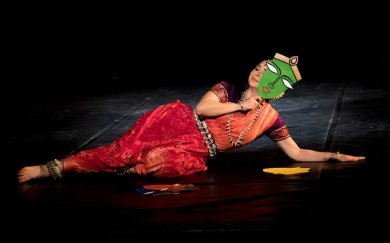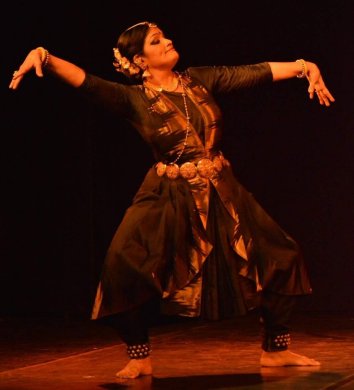
|   |

|   |
AH SU RA: Pushing frontiers - Prasanna Ramaswamy e-mail: prasannarama21@gmail.com Photos: Ganesh Ramalingam January 5, 2018 The moonlit courtyard of Chandralekha's Spaces witnessed three women dancers who were trying to push frontiers to make visitations to, investigate, repossess and embody three characters from Ramayana. Interestingly, the unifying factor seemed to be 'desire' which comes under the control of hegemonic tendencies. Three solos which were otherwise independently choreographed at different timescales were on stage. While Sharmila's Surpanaka and Geeta's Ravana are seasoned a few years, Anita's Ahalya is just born, at least this version. Anita Ratnam makes her second visitation to the myth of Ahalya, the woman cursed to become a stone as a punishment to her straying out of wedlock and fulfills her desire, 'seduced' by Indra, the irresistible male, according to the myth. The soundtrack of night sounds of a jungle filled the atmosphere as the audience gathered at wait. Taking off from the visuals of the much celebrated solo of Martha Graham to Zoltan Kodaly's haunting music, Anita's cloak is all covering and made of stretchable all gold material into which she is straining and stressing to break away, thus indicating the breaking away from the limited notions about Ahalya. Accompanied and preceded by Anita's recorded voice speaking the text of Ahalya's monologue in third and first person, with projected text and enacted on a set made of stones and pebbles of golden colour, it again makes a statement about the glorification by the orthodoxy of Ahalya, a woman imprisoned in stone, waiting to be given life by God even as the agony is spoken out through movements to liberate oneself, to the sounds of chiselling on the sound track. The movement pattern shunned any established vocabulary but stressing towards freeing oneself. The concrete visuality at once connected the handed down image and the psychological stress of and about Ahalya was another that the dancer is engaging with. To free her for oneself, to claim her for the now and here.  Anita Ratnam The golden colour flipped and became molten lava, the imprisoned mind and body of Ahalya. After that Martha Graham (Lamentation) inspired take off, the Ahalya flies into the air, claims her space and tells the world about her free soul, not in a negative rage or impositioning the other but through assertion and reclamation. The postures and projected wordings constantly connecting to the gendered realities of now, of the here, Anita tries to find Ahalya. The work transcends Ahalya and attempts to engage with the question of desire and the neutrality of it, the need to it and the right to it, for a woman. The ‘poor’ Ahalya seduced and misled by Indra as she is stamped is not the woman Anita is settling with here. She is negotiating and engaging with a woman who claims her right to desire. The work has much potential to travel, unravel and claim its layered form. Anita always takes courage and risk to share her work at its nascent stage and allows it to grow through performances. It will eventually happen with this too, I am sure.  Sharmila Biswas Sharmila Biswas, a wonderful Odissi dancer, presented her interpretation of Shurpanaka, a Shurpanaka who is a woman like you and me, who is a creature of nature, a free woman. She is puzzled at why her legitimate desire is turned down, maligned and why she gets defaced. Starting off differently than a regular traditional piece, Sharmila used masks to speak on several hitherto unspoken Shurpanakas of her different ages and then burst out into an exquisitely choreographed character narrative. Shurpanaka was evoked in her different hues. Unlike many Odissi pieces which become somewhat unbearably syrupy after five to seven minutes, Sharmila sustained the interesting lasya content even as she negotiated the strong character and emotions, much by weaving in pure dance to heighten the drama, the same element which Geeta Chandran adapted to enhance the character she had chosen, Ravana.  Geeta Chandran A very interesting costume added dramatics to Geeta's denouement of Ravana’s appeal to Sita. Choreographed much from the conventions of a mixture of Virahothkantitha, Vipralambha and Vasakasajjika Nayika's shringara position transposed to a male, interwoven with energetic jatis and traversing the diagonal space of the stage, Geeta portrayed a Ravana, a character of great beauty and strength as seen in Koodiyattam and Kathakali. Going by the post Sadir, brahminical conventions of creating characters by position changes, she did create Sita too at two points, a Sita who was disgusted, defenseless and scared. It was a redundant moment which brought in an aesthetic problem in terms of the sthayi, which was desire, shringaram. The opposing emotion of disgust couldn't fit into the grid of sanchari besides weakening the much aroused and confident Ravana. As against the two strong women in the other two acts who are questioning the hegemony, the Sita here became a weak woman. Anyway, can’t recall any other Bharatanatyam woman dancer negotiating such a heavy character and essaying male shringara. Prasanna Ramaswamy is a Theatre Director based in Chennai. |